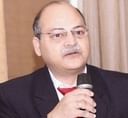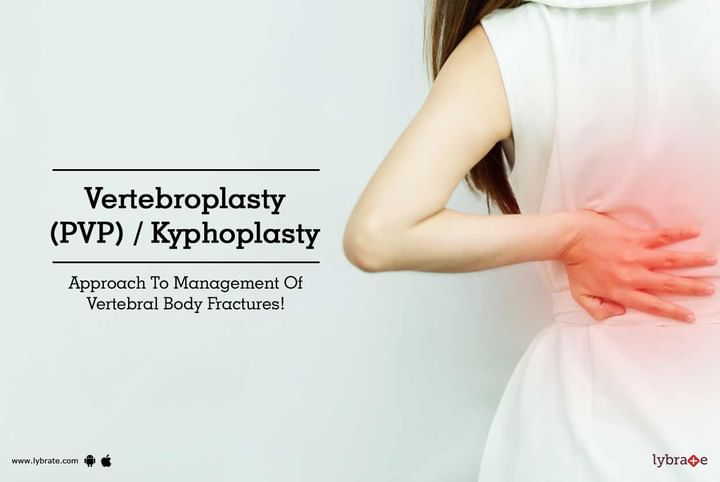Vertebroplasty (PVP) / Kyphoplasty - Approach To Management Of Vertebral Body Fractures!
As life expectancy is increasing so is the incidence of vertebral body (VB) fractures now being the commonest fracture of the body. PVP is an established interventional technique in which bone cement is injected under local anaesthesia via a needle into a fractured VB with imaging guidance providing instant pain relief, increased bone strength, stability, decreasing analgesic medicines, increased mobility with improved quality of life and early return to work in days.
In this era of minimally access surgery replacing open surgeries, PVP is a novel procedure & should be in the first line of management in place of conservatism or major spine surgery for painful uncomplicated compression fracture spine.
Morbidity & consequences of spinal fracture:
- Traumatic VB is a painful condition requiring bed rest restricting daily activities markedly
- Left untreated it can cause DVT, increase osteoporosis, loss of VB height, respiratory & GI disturbances, emotional & social problems secondary to unremitting pain, loss of independence with high cost of rehabilitation.
- High risk of primary or consequential damage to neural, bony or disc element
- Increased wedging, deformity & increase incidence of adjacent VB
- Chronic pain of altered spine mechanics
- Uncomfortable braces & sleep disturbance because of pain & discomfort with its sequels.
- Cost of surgery and hospital treatment
- Cost of implants
- Phobia of surgery
- Prolonged recovery period & Extensive rehabilitation
- Changed spinal mechanics & transition syndrome
- Major surgery & anesthesia with its own complications
Results / Outcome
- PVP is a novel procedure with high benefit to risk ratio, which is highly underutilized in relation to the high prevalence of the vertebral.
- Different studies show an immediate pain relief in (85 – 90)% of patients with low complication rate ranging from (1-5)% depending upon the type of lesion.
- PVP does augment height of VB but ideal would be kyphoplasty
- Patient is either off medicine or on reduced doses.
- Patient feels so well that he almost forgets if he had VB
Percutaneous Vertebroplasty (PVP) is an emerging interventional technique in which surgical polymethyl methacrylate bone cement is injected under local anaesthesia via a large bore needle into a vertebral body (VB) under imaging guidance providing increased bone strength, stability, pain relief, decreased analgesics, increased mobility with improved QOL and early return to work. Started in 1984 by Galibert PVP is done in host of indications.
Senile osteoporotic compression remains the commonest Indication. Other indications are Metastatic VB, Multiple myeloma VB, VB haemangioma, Vertebral osteonecrosis & for strengthening VB before major spinal surgery. The benefit has been extended to the traumatic stable uncomplicated VB compression (VCF) which is commoner in younger age group with active life profile and prime of their career where strict bed rest and acute or chronic pain are unacceptable and they are more demanding for proactive treatment approach so as to be back to work ASAP.
Discovering the fact that VB is the commonest of body, its incidence >the hip, it becomes imperative to take it more seriously. With increasing life-span there is more of aged osteoporotic population, more so due to sedentary indoor lifestyle and post menopausal osteoporosis. Diabetics, smokers & alcoholics are at higher risk of developing osteoporosis. I have seen such alcoholic patient developing six spine fractures in just three months time from a single fracture being on complete bed rest.
Quick fix of fracture spine makes patient walk back same day instead of bed rest of months together avoiding morbidity & mortality of prolonged bed rest, making bedridden patient walk, in a way bringing patient back to normal life.
In this era of MAS replacing open surgeries, PVP is a novel procedure & should be in the first line of management in place of conservatism or major spine surgery for painful uncomplicated compression.
Morbidity & consequenses of spinal
- Traumatic VB is a painful condition requiring bed rest restricting daily activities markedly.
- Left untreated it can cause DVT, increase osteoporosis, loss of VB height, respiratory &
- GI disturbances, emotional & social problems secondary to unremitting pain, loss of independence with high cost of rehabilitation.
- High risk of primary or consequential damage to neural, bony or disc elements.
- Increased wedging, deformity & increase incidence of adjacent VB
- Chronic pain of altered spine mechanics.
- Uncomfortable braces & sleep disturbance because of pain & discomfort with its sequels.
Morbidity and complication of spinal surgery
- Cost of surgery and hospital treatment
- Cost of implants
- Phobia of surgery
- Prolonged recovery period & Extensive rehabilitation
- Changed spinal mechanics & transition syndrome
- Major surgery & anesthesia with its own complications
Preparation & Procedure:
X-ray spine in a/p & lat view. CT is more informative of bone & morphology. MRI is good for soft tissue injuries. Ask for pedicle size in all dimensions and construct a 3D image aiming needle placement and cement filling in scan room itself as rehearsal of PVP. This reduces operative time & gives better results. Conventionally PVP is done by hammering the vertebroplasty needle through the bone. Here we use light weight drill to bore through the vertebra. It is important to set the needle at exact entry site & side with right trajectory aiming the defects.
In lateral view needle should go through middle of the pedicle going up to anterior 1/3 of VB. In P/A view the needle can be in midline or paramedian depending upon & if uni/bipedicular approach is planned. Approach varies as per location of vertebra, anterolateral in cervical, costotransverse/parapedicular in thoracic & transpedicular in lumbar vertebra.
Do bone biopsy if there is any doubt about lession. Do dye test (vertebral venography). Make cement more radiopaque by adding barium /or tungsten. Inject cement with 1or2 ml luerlock syringes strictly under fluoroscope in lateral view & cross checking in P/A view. Stop injecting either there is adequate filling or at the first sight of ectopic cement leak. Keep sample cement to see for hardening. Remove needle with rotational movement before cement hardens.
Pain relief is by virtue of different mechanisms postulated :
- Cementing of fragments.
- Thermal neurolysis of VB nerve ending due to heat of polymerization.
- Washing away of nociceptor chemicals.
- Neurolytic action of liquid monomer.
- By allowing early ambulation decreasing pains of immobility & bed rest.
Complications
- PVP is generally safe with low risk.
- Ectopic cement leak is frequent but generally inconsequential.
Outcome
- PVP is a novel procedure with high benefit to risk ratio, which is highly underutilized in relation to the high prevalence of the vertebral
- Different studies show an immediate pain relief in (85 – 90)% of patients with low complication rate ranging from (1-5)% depending upon the type of lesion.
- PVP does augment height of VB but ideal would be kyphoplasty.
- Patient is either off medicine or on reduced doses.
- Patient feels so well that he almost forgets if he had VB
In case you have a concern or query you can always consult an expert & get answers to your questions!



+1.svg)
